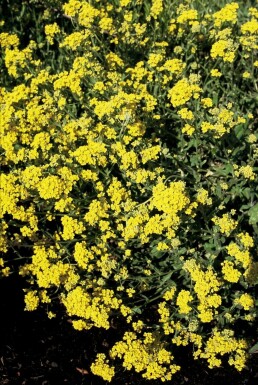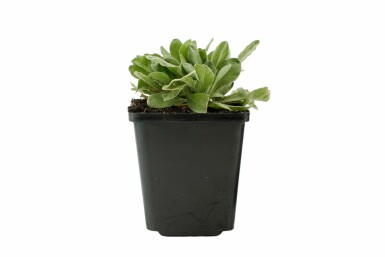

30cm



Updated on 10 September 2025
We regret to inform you that we are currently unable to ship orders to the United Kingdom. We anticipate being able to resume shipments at the beginning of 2026.
Aurinia brings vibrant yellow blooms to a sunny rock garden, thriving in dry embankments and borders. This drought-resistant plant attracts bees and requires little maintenance. Perfect for edge planting, it self-seeds, ensuring enduring beauty through spring and summer.


30cm



Aurinia is a standout choice for adding vibrant colour to a rock garden. Known for its intense golden-yellow blooms, this plant creates a striking display in spring. The small gray-green leaves form a compact growth habit, making it perfect for dry embankments and sunny spots. Its mat-forming nature makes it ideal for stone gardens, providing a cheerful touch. Explore the beauty and resilience of basket-of-gold in your garden. With its drought-tolerant qualities and fragrant blooms, Aurinia is a must-have for any border or spring accent. This plant is not just a visual delight but also attracts bees, supporting biodiversity. Discover how this bright plant can transform your outdoor space today.
Aurinia, commonly known as basket-of-gold, is a stunning drought-tolerant groundcover. This plant, also called golden alyssum, is celebrated for its bright yellow blooms that bring a burst of colour to gardens. It's often used in rock gardens, edge planting, and wall planting. Belonging to the Brassicaceae family, Aurinia thrives in sunny spots, offering a delightful display during its flowering duration. Native to Southern Europe, the Balkans, and Asia Minor, Aurinia is ideal for UK gardens, adding beauty and charm. It plays an important ecological role as an early spring bloomer, attracting insects and providing erosion control in alpine zones. The name 'Aurinia' comes from the Latin 'aurum', meaning gold, symbolising joy and abundance. Aurinia groundcover is a perennial known for its mat-forming appearance. Though short-lived, it often self-seeds, ensuring continuity in gardens. This rock garden flower is perfect for those seeking vibrant yellow rockery flowers. Aurinia seeds can be easily purchased for those looking to add this resilient plant to their collection. Whether known as basket-of-gold or rock garden flower, Aurinia remains a popular choice for gardeners seeking sun-loving, low-maintenance beauty.
Aurinia is a sun-loving perennial that adds colour early in the season. This plant grows low to the ground, forming a cushion-like blanket that serves well as ground cover. It is drought-tolerant and thrives in rock gardens, along edges, or even in pots and planters. As a ground cover, it forms small gray-green leaves and displays clusters of intense golden-yellow flowers, especially noticeable during its flowering months from April to June. These blooms are umbel-shaped and provide a vibrant, fragrant spring display in the garden. The development of Aurinia begins with its gray-green foliage, which sets the stage for its bright blooms. These flowers usually appear in their full glory from the second year onwards. Aurinia's ability to self-seed allows it to maintain its presence even though it is short-lived. During the flowering months, weather and adequate sun exposure play significant roles in the quality and duration of the bloom. The mature height of Aurinia varies between 10 cm and 25 cm, influenced by factors such as plant variety, location, and care. While not particularly known for a strong scent, its presence enriches the biodiversity of the garden, attracting pollinators. As part of its care, ensuring well-drained soil and proper sun exposure can enhance its growth and flowering potential, making it an essential plant for any rock garden enthusiast.
Aurinia is a unique plant with small, oval to elongated leaves that are often covered in fine hairs. These leaves present a grey-green to silvery hue, adapting well to various environments by reducing evaporation. This structure makes Aurinia particularly suitable for gardens with dry, poor soils. For those looking to grow Aurinia saxatilis in UK gardens, it's essential to note its ability to maintain foliage throughout mild winters, thanks to its moderate hardiness. This plant can withstand temperatures as low as -23°C, thriving specifically in USDA zones 6 to 8, particularly in dry, sunny spots. Despite not being evergreen, Aurinia sheds its leaves annually, yet it remains a garden favourite due to its early spring bloom from March to April. Originating from areas with harsh conditions, Aurinia has developed a robust tolerance to both drought and heat. Its hairy leaves and deep root system contribute to its resilience against moisture scarcity and wind exposure. When it comes to safety, Aurinia is non-toxic, making it a safe choice for gardens frequented by children and pets. In terms of biodiversity, Aurinia offers significant ecological benefits. Its striking yellow bloom not only adds visual appeal but also attracts bees, enhancing pollination. Aurinia’s natural resistance to diseases and its role in rock gardens make it a valuable addition to garden ecosystems.
Aurinia is a wonderful choice for gardeners looking to add brilliant colour and texture to their spaces. This mat-forming plant is perfect for various garden settings.
With its stunning, yellow rockery flowers, Aurinia creates a cheerful and inviting atmosphere in gardens. Whether used as groundcover or in rock gardens, it offers a low-maintenance option that brings life to any outdoor space. Consider adding this delightful plant to your landscape and enjoy its vibrant blooms all season long.
For those looking to enhance their garden with basket-of-gold, this plant is an excellent choice. Its ability to thrive in dry conditions makes it a practical and attractive addition. Buy basket-of-gold to transform your garden into a vibrant haven.
Aurinia is a perfect addition to a sunny rock garden. Pair it with Festuca glauca for a lovely contrast in texture. The soft blue of Festuca against the bright yellow of Aurinia is stunning. Euphorbia is another excellent choice. Its unusual shape and green tones complement the golden hue of Aurinia beautifully. Sedum is a great companion too. It’s also drought-tolerant, making it ideal for dry embankments. Achillea and Allium are wonderful as well. They add height and different colours, enhancing the visual interest in a border planting. Aurinia blooms profusely in spring and forms a colourful duo with other garden plants. These combinations are not only visually appealing but also attract bees, enriching the garden's biodiversity. Aurinia (basket-of-gold) and its companions create a fragrant spring bloomer display that thrives in dry conditions.
Aurinia thrives best in full sun, needing at least 6 hours of sunlight each day. It's important to consider factors like location and obstacles that might block sunlight. This plant is not particularly sensitive to wind. However, placing it near other plants or using windbreaks can help if needed. Aurinia prefers rocky, well-draining soil, often found in mountain areas. Soil should be dry to moderately moist to ensure healthy growth. Proper fertilisation and drainage are key for the Aurinia groundcover to flourish. Maintaining optimal soil moisture is crucial, especially in windy or sunny conditions. The soil should retain enough moisture without becoming waterlogged. When it comes to pH levels, Aurinia favours slightly alkaline soil. Checking soil pH and adjusting with lime if needed can improve conditions. Overall, understanding these needs helps Aurinia, such as rock garden flower varieties, to thrive in any garden setting.
Planting Aurinia in the garden is best done in spring. It is perfect for rock gardens and thrives in rocky, dry, calcareous mountain soils. This drought-tolerant plant prefers a sunny spot, with at least 6 hours of sunlight daily. When planting, ensure the soil is well-drained by adding gravel or coarse sand. Basket-of-gold plants can be planted year-round if they come in pots, except during frost periods. If planting with a root ball, it's ideal during spring or autumn. For the best impact, consider the plant distance carefully. This rock garden plant should be spaced based on its size at planting and growth rate. Information on the number of plants per metre is available on the Heijnen product page. Prepare the ground well with Heijnen planting soil for optimal growth. When planting, firm the soil and water only during drought conditions. Aurinia, including the beautiful basket-of-gold, requires minimal aftercare. Just ensure the soil stays dry, and there's no need for frequent watering or fertilising. This fragrant spring bloomer brightens any garden effortlessly.
Aurinia is a delightful plant that adds vibrant colour to any garden. Proper care ensures its health and beautiful early spring bloom. Here's how to maintain Aurinia in the best way possible:
These simple steps help keep Aurinia thriving and ensure stunning displays of basket-of-gold blooms. Perfect for rock gardens and groundcover, this plant brings early spring joy and supports local insects.
Aurinia shines in gardens with its bright yellow blooms. This plant stands out as a stunning choice for sunny areas. The grey-green to silvery leaves add a soft texture, making it visually appealing. Its flowers are golden yellow and umbel-shaped, providing an eye-catching display. Known as a rock garden plant, Aurinia is highly drought-tolerant, making it perfect for dry spots where other plants might struggle. Basket-of-gold, or Aurinia, is favoured for its long flowering period and low maintenance needs. It forms a cushion-like mat that covers the ground, ideal for borders and dry embankments. In addition, it serves as an excellent bee plant, attracting numerous pollinators. Aurinia blooms bright yellow and is a striking rock plant for sunny spots. Its self-seeding nature ensures it returns year after year, providing vibrant colour and texture to gardens. Choose Aurinia for its resilience and beauty, a true standout in any garden setting.
Aurinia, commonly known as basket-of-gold, is a popular plant choice for UK gardens, especially in gravel and rock settings. These mat-forming plants are renowned for their vibrant golden blooms, which provide an eye-catching display during the early spring months of March and April. The flowers thrive in dry soil conditions and prefer full sun exposure, making them ideal for sunny garden spots. Here are some popular Aurinia species that are widely used and appreciated:
Aurinia, commonly known as basket-of-gold, is a popular choice for gardeners due to its beautiful yellow flowers and ease of care. Here are some key advantages and disadvantages:
Advantages:
Disadvantages:
Proper soil preparation, choosing the right location, and correct care along with timely fertilisation can reduce the risk of diseases and pests. Regular care will ensure Aurinia (basket-of-gold) grows and blooms well.
For a vibrant and early spring bloom, Aurinia is an excellent choice. Perfect for adding a bright yellow touch to sunny rock gardens, dry embankments, and borders, this plant excels in various garden settings. When considering Aurinia, Heijnen offers top-quality seeds that ensure a flourishing garden display. Aurinia is extremely drought-resistant, making it ideal for low-maintenance gardens. Its long flowering duration from March to April brings a cheerful yellow to any rock garden. Renowned for attracting beneficial insects, it enriches the garden's ecosystem. The basket-of-gold flowers add a stunning visual effect that enhances any landscape. This plant self-seeds, effortlessly spreading beauty year after year. This trusted variety, known for thriving in sun-exposed areas, brings ease and beauty to gardening. The vibrant basket-of-gold flowers withstand tough conditions, ideal for creating a stunning yellow flower border. Buy Aurinia (Basket-of-Gold) from Heijnen and enjoy a sun-drenched yellow bloom explosion in spring with this dependable variety.
We would like to provide some tips on how to plant and care for a Aurinia. By following these tips, you can be sure to enjoy your Aurinia for a long time.
Aurinia grows best in sunny locations with well-drained, rocky or calcareous mountain soils. This plant thrives in full sun, needing at least six hours of sunlight daily. It's important to choose a location with dry to moderately moist soil to ensure healthy growth. The ideal spot offers protection from strong winds. Planting Aurinia in the right place leads to better growth and vibrant yellow blooms, providing a stunning addition to any garden. It is well-suited for rock gardens, dry embankments, or as a striking border accent. Aurinia is particularly tolerant of poor, dry soils, thanks to its felted leaves that reduce evaporation. This makes it an excellent choice for sunny rock gardens or stone gardens. Ensuring the correct location is essential for the plant's growth and flowering potential.
Preparing the soil is crucial when planting Aurinia. Start by loosening the soil to improve drainage using gravel or sand. This helps water and nutrients reach the roots effectively. Mixing in organic materials like compost enhances soil quality, benefiting plant growth. Proper soil preparation ensures that basket-of-gold plants establish well in the garden. Potted Aurinia can be planted year-round, avoiding frosty periods. For those with a burlap-wrapped root ball, plant with the burlap intact, ideally in spring or autumn. After planting, provide water until the roots are well-established in the ground. The plant's size at the time of planting determines how many Aurinia should be planted per square metre for optimal coverage. Remember, a well-prepared soil promotes healthy and vibrant Aurinia growth, making a stunning addition to the garden.
Fertilising Aurinia is crucial for maintaining its growth and health, ensuring it thrives as a vibrant garden feature. Regular feeding supports its stunning golden yellow blooms and enhances its overall vitality. Using an organic or organic-mineral fertiliser from Heijnen is recommended, as it promotes robust growth and a rich flowering display. Fertilisation should be done twice a year, in spring and summer, tailored to the specific needs of the plant. In spring, a light composting is ideal, especially if the soil is poor. The amount of fertiliser depends on the plant's size; larger plants require more. Nutrients are absorbed when dissolved in water, so during dry periods, watering is essential to activate the fertiliser for the roots. This ensures that nutrients are adequately absorbed, supporting the basket-of-gold's health and beauty.
Aurinia benefits from regular pruning to promote healthy growth. It is important to prune this plant after flowering, typically between May and June, to maintain its shape and remove faded flowers. The plant prefers dry, calcareous soil, and rejuvenating the rosette every three years helps keep it vibrant. Regular pruning enhances air circulation and encourages new blooms. Using sharp secateurs is essential for clean and precise cuts, preventing damage and disease. Proper tools make the pruning process more effective and ensure the plant remains healthy. For optimal results, firm pruning is recommended, making sure to shape the plant nicely. Paying attention to these details helps Aurinia, also known as basket-of-gold, thrive in any garden setting.
Aurinia has a low water need and is highly drought tolerant, making it perfect for dry, rocky, and calcareous soils. Newly planted Aurinia plants must receive enough water initially to establish their roots. Once established, they only require watering during prolonged dry spells. It is better to water deeply rather than giving a little water every day. The best time to water is early morning or late afternoon to minimise evaporation. It is important to check the soil moisture to see if the plant really needs water. Ensure excess water can drain away, whether in the ground or in pots. Drip irrigation systems are effective only when the plant is fully rooted, so additional watering may be necessary in the beginning. Aurinia's high drought tolerance makes it an excellent choice for gardens with low water availability.
Aurinia is cherished for its vibrant yellow flowers. It is a symbol of joy and abundance, making it a cheerful addition to any garden. Originating from the Latin word ‘aurum’, it represents gold. This plant is drought-resistant and attracts beneficial insects, offering long blooms with minimal care. Aurinia is also safe for children and pets. Known as basket-of-gold, it adds a bright touch to rock gardens and serves as a spring messenger.
Aurinia, also known for its vibrant yellow flowers, benefits from division. Dividing Aurinia helps rejuvenate the plant and maintains its health. It is important to divide Aurinia regularly to remove old, dead parts and keep the plant vigorous. The process involves digging up the clump and gently separating young sections from older parts. Replant the young sections for a fresh start. This should be done every three to four years. The best time for dividing is in spring when the weather is mild. Important tools include a garden fork and a sharp knife for precise cutting. Regular division prevents overcrowding and encourages abundant blooms. Aurinia, like the basket-of-gold, thrives when divided correctly, ensuring a healthy garden display.
Basket-of-gold is a striking addition to any garden, known for its intense golden-yellow blooms and compact growth. This yellow rockery flower thrives in sunny rock gardens and dry embankments. Its low-maintenance nature makes it perfect for busy gardeners. Extremely drought-resistant and self-seeding, it attracts insects and provides early spring blooms. Buy Aurinia (Basket-of-Gold) from Heijnen and enjoy a sunlit garden accent.
